https://ift.tt/3mhl6tB
If you are new to the low-carb or keto diet and eager to reap the weight loss and health benefits of this amazing lifestyle then you may be wondering how many carbs per day to include in your meals and snacks.
While the answer to this depends on a few factors, which are comprehensively outlined below, the short of it is that you’ll want to aim for 20 - 50 grams of net carbs per day to start seeing some great results.
And while cutting carbs may seem like a tall ask, it’s actually way easier than you think. Of course, I’m here to walk you through each step of the way!
Jump to:
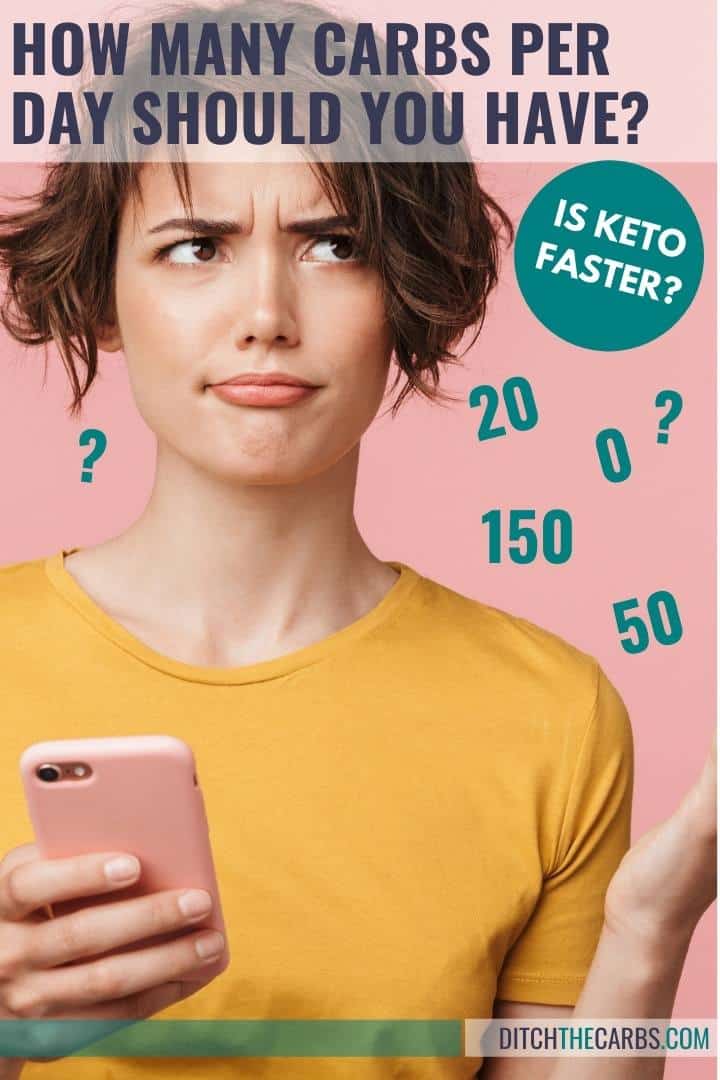
HOW MANY CARBS PER DAY SHOULD I EAT TO LOSE WEIGHT?
This question is a common one although there are a few factors that you should consider before jumping right in which will set you up for weight loss success and overall health improvements:
Even A Reduction of Carbs Will Result Help With Weight Loss
If you have been consuming a high intake of carbs for a long period of time then any reduction of carbs over time may eventually result in weight loss. This is due to the fact that you’ll likely have reduced your total daily calorie count as your hunger diminishes.
With that said, there’s no point in reducing your daily carb intake if the majority of your remaining carbs are processed. In other words, carbs that are found in bleached and processed flours, fast foods, and the like.
At Ditch The Carbs PRO, I always promote a whole-food approach, meaning that you shouldn’t just focus on reaching your macro counts without considering the quality (or lack thereof) of foods but that you should be striving to reach your macros with quality, whole foods that will provide the adequate nutritional value your body can use. This is where clean versus dirty keto comes in.
Quantity AND quality of your carbs are important to monitor.

If you aren’t familiar with “dirty” and “clean” keto, have a read of my “What Is Dirty Keto” post here.
The Level of Carb Restriction Impacts The Amount of Possible Weight Loss
Apart from eating unprocessed carbs, your weight loss success also depends on what level of carb restriction you adhere to.
But don't think going lower will give you more rapid results. If the level of carb restriction is not sustainable for you and your lifestyle, you will continually have "cheat days" and feel a sense of failure.
Instead, choose a level that you can live with easily and sustainably whilst still achieving results.
To give you a better idea of what is considered moderate to low carb as well as keto, here is a breakdown of the amount of carbs to aim for depending on your weight loss goal:
<100g/day = moderate low-carb
<50g/day = low-carb
<20g/day = keto
Recommended Carb Intake Based On Several Physical Factors
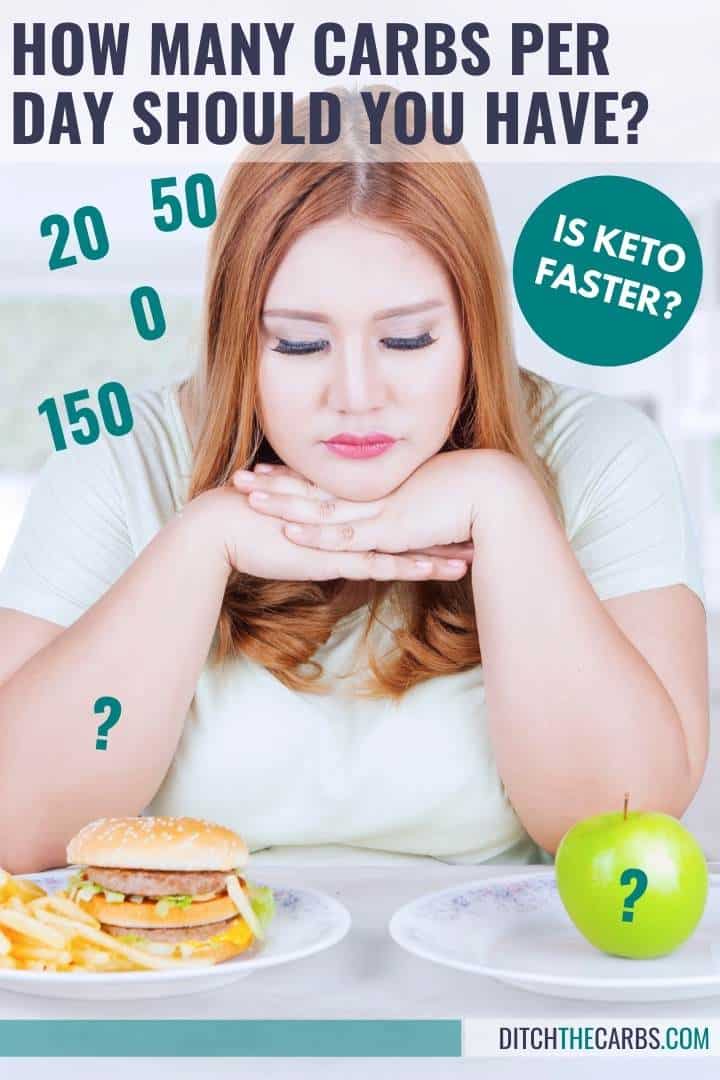
Since everyone is different it makes sense then that the number of carbs you should be eating per day for weight loss depends on factors such as age, sex, body type and current activity level.
To get a great indication of how many carbs you should be eating per day, try out my macro calculator! Besides providing you with an accurate macro split for optimal weight loss.
It’ll also provide you with a guide to how much protein you should be having depending on your level of activity.
Pre-existing Health Conditions To Consider
A low-carb diet followed consistently over time has been recorded to reverse health conditions such as type 2 diabetes.
If you have any pre-existing medical conditions, always keep your healthcare provider updated of any dietary and lifestyle changes you intend making with follow up consultations especially since this diet can substantially reduce your medication requirements!
IS IT BETTER TO COUNT CALORIES OR CARBS?
You may have come across two common approaches to weight loss - counting overall daily calories versus solely concentrating on counting carbs. But which is best for optimal and healthy weight-loss?
The Difference Between Calorie and Carb Counting
Calorie counting places emphasis on total calories in versus total calories out, highlighting the importance of always being in a calorie deficit (in other words, you consume less than the energy you expend on a daily basis).
The challenge that most find with this approach to weight loss is twofold.
- You either need to constantly be increasing your daily exercise to burn off residual energy supplies from food consumed
— or — - You need to reduce your food intake as you lose weight because your daily calorie intake must be adjusted to your new weight every few weeks
Both approaches just leave you hungry and tired. Calorie counting NEVER addresses the issue of hunger.
On the other hand, counting carbs places the emphasis on ensuring that you adhere to a particular amount of carbs per day which will differ depending on whether you are following a moderate to low carb diet or the keto diet with a limit of 20 grams of net carbs (total carbs less fibre), placing you in a fat-burning state known as ketosis.
Weight gain is a hormone imbalance, not a calorie imbalance.
Insulin is our fat-storing hormone. When you live on a chronic high-carb diet, your sugar and insulin levels are always in the fat-storing mode, not fat-burning mode.
Counting Calories vs Carbs: Which Weight Loss Method Is Better?
Each of these two methods of weight loss has merit. However, there is growing evidence for advocating the carb counting method over the calorie counting method and these are two main reasons why:
Firstly, the calorie counting method has the potential of ignoring an adequate split in the three macronutrients (fat, carbs and protein) for the most efficient fat burning.
It is possible for a person to be in a calorie deficit while consuming higher amounts of carbs compared to a person following a low-carb or keto diet.
The person eating high carbs while being in a calorie deficit will likely experience cravings and hunger which could make this method unsustainable long-term.
Because carbs are broken down into sugar in our bodies, this stimulates an increase in insulin and elevations in insulin can increase hunger.
Secondly, at some point in every weight loss journey a person will likely experience a weight loss plateau.
While a low-carb or keto follower will simply adjust their carb content to push through the plateau, someone following the calorie deficit method has to further reduce their total calories resulting in a slower metabolism, which in turn makes it even harder to lose any further weight.
The latter scenario is what is referred to as a “calorie deficit paradox”.
WHAT DO I EAT ON A LOW-CARB AND KETO DIET?
While weight loss is one of the driving factors for a person to follow a low carb or keto diet, by now I’m sure you would have noticed that I advocate this lifestyle for improved overall health alongside weight loss.
Consequently, whole and unprocessed foods are a priority should you be adhering to a clean keto diet for maximum weight loss success and improved health.
Tips for Eating Whole and Unprocessed Foods
#1. Don’t Drink Your Carbohydrates
Alcoholic drinks with mixers have a very high sugar content and the same can be said for sodas, fruit juice and other sugary drinks like energy drinks.
Instead, stick to water, tea and coffee. Enjoy hard liquor such as whiskey, vodka, gin and tequila with sparkling water (unsweetened and without flavors).
#2. Avoid Junk Foods and Fast Foods
These offer no nutritional value and are packed with sugars and carbohydrates that will definitely kick you out of ketosis and sabotage your weight loss efforts.
#3. Read Food Labels Carefully
Always read the food labels (especially the nutritional facts label) on packaged foods. Just because a product says “keto” doesn’t necessarily mean that it is in fact low-carb or keto.
Furthermore, it’s likely to include processed ingredients!
#4. Use Low-Carb Alternatives When Preparing Meals
This includes zucchini or squash noodles in place of flour-based pasta.
Using keto-friendly sugar alcohols and sweeteners in place of refined table sugar for hot beverages and baking.
Sticking to low carb vegetables that have a good fiber content instead of starchy vegetables.
#5. Cook Copycat Recipes
This helps to make you feel like you aren’t missing out on any of your favorite meals. Check out these 29 Low-Carb and Keto Copycat Recipes to get you started.
To get a detailed list of the kinds of foods to include in your low-carb and keto diet, check out my Keto Food Pyramid together with the Top 10 Keto Snacks On The Go.
WHAT ARE THE WORST CARBS TO EAT?
Due to a low-carb and keto diet containing a daily carb limit of 20 grams, it’s vitally important to understand which foods are particularly high in carbs so that you can limit them or completely avoid them to facilitate your weight loss goals.
The following foods are those that need to be limited or avoided completely on a low-carb and keto diet:
Carbs Found In Beige Foods
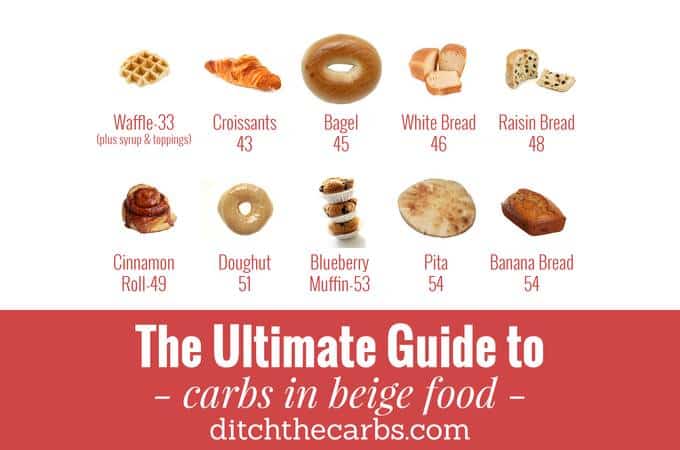
Most beige foods such as pasta, sweetened cereals, bread, grains, and beans are very high in carbohydrates and unfortunately are found in most every day food staples that most of us have grown up on.
The Ultimate Guide To Carbs In Beige Foods is a comprehensive resource for you to utilise when cutting out refined and processed foods from your diet.
Here’s a short outline to give you an idea of the carb content found in these types of foods which may shock you:
- 1 slice of white bread contains 14 grams of carbs with only 1 gram of fibre.
- 1 slice of whole-wheat bread contains 17 grams of carbs with only 2 grams of fibre
- A standard size flour tortilla contains 36 grams of carbs with only 2 grams of fibre
- 1 bagel contains 29 grams of carbs with only 1 gram of fibre.
Carbs In Fruit
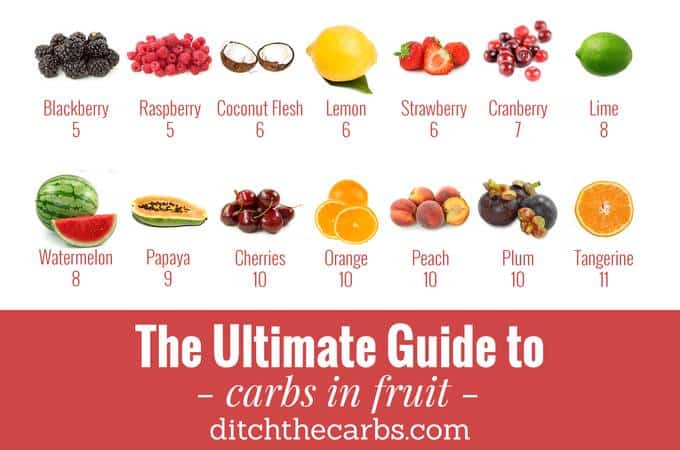
While it’s true that a high intake of fruits and vegetables are good for health and linked to preventing disease, there are still those that are particularly high in carbohydrates and will threaten to kick you out of ketosis when consumed.
In addition, fruit is generally not very nutrient dense. Spend your carbs wisely, and always base your meals and snacks on quality protein, healthy fat and non-starchy vegetables.
Although “an apple a day keeps the doctor away”, this particular fruit as an example consists of 21 grams of carbs and 4 grams of fibre, meaning that a small apple is a total of 17 grams net carbs.
That’s almost your entire day’s limit of carbs in one small fruit!
To prevent you from going over your daily carb limit, you will need to limit or avoid certain fruits, whether fresh or dried. Those with high carb content include apples, bananas, raisins, dates, and mango.
While berries tend to be lower in carbs, you must not fall into the trap of overindulging.
Check out The Ultimate Guide To Carbs In Fruit for an indepth look at which fruits to avoid or limit when following a low-carb or keto lifestyle.
Carbs Found In Starchy Vegetables
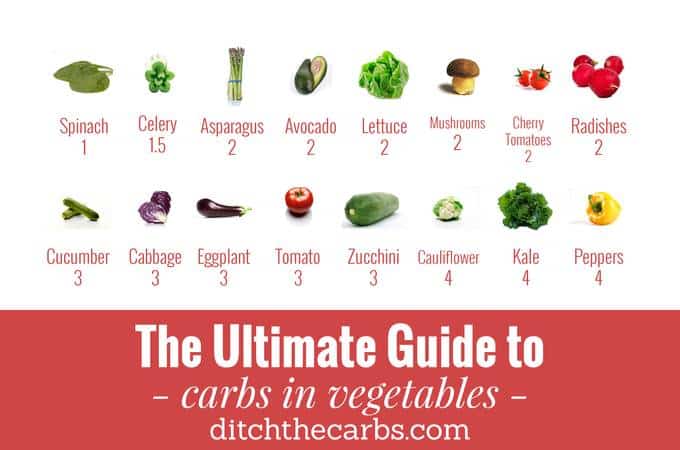
Starchy vegetables contain a higher level of digestible carbs than fibre and need to be limited or avoided as a result when on a low carb diet.
Some common examples of starchy vegetables that go well above the 20 grams carb limit include corn, potato (including sweet potato) and parsnips, to name a few.
For a more comprehensive list, check out The Ultimate Guide to Carbs In Vegetables.
Carbs Found in Beverages
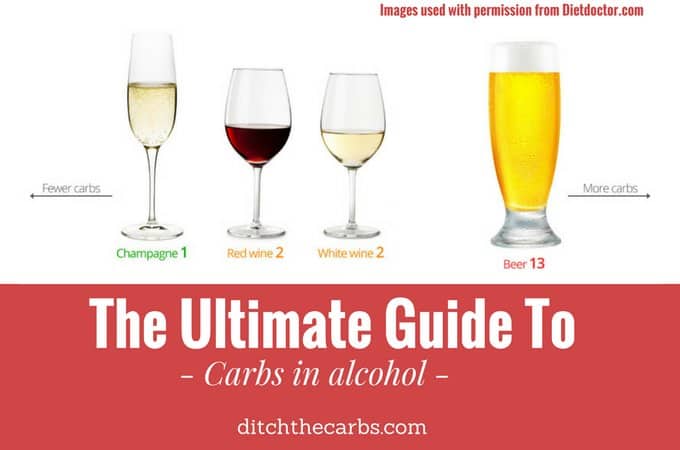
You will find that carbs are particularly high in content in alcoholic beverages such as cocktails, beers, sweet wines and other drinks that mix hard liquor with sweetened mixers.
It’s best to stick to dry wine, hard liquors (minus the sweetened mixers) and low-carb beer options.
Fruit juice and sodas are also very high in sugars and carbohydrates and should be avoided entirely.
It’s very easy to go over daily carb limits by drinking carbs and it’s why I always caution against drinking your carbs.
Carbs Found In Sweetened Products
Skip the sweetened yoghurts and opt instead for plain full fat yoghurt.
This rule applies to all products that have a sweetened version of their original as the carb intake is much higher due to added sugar and additives.
Carbs Found In Low-Fat and Fat-Free Products
Over the years, we have been made to believe the lies of commercial giants in the food industry and the low-fat and fat-free movement is one of those lies.
Low-fat and fat-free products contain many other ingredients, including added carbs, in order to compensate for lack of taste due to the fat content having been stripped away.
It’s always a healthier option to stick to full-fat unprocessed options.
Carbs Found In Natural Sugar
Sugar is sugar, regardless of whether it is refined and processed or from a natural source such as honey. And many of these natural sugars are as high in carbs as their processed counterparts!
Take honey as an example. There are 17 grams of carbs in 1 tablespoon! Following closely behind is agave nectar with 16 grams and maple syrup with 13 grams.
When needing to sweeten food or beverages, choose a low-carb sweetener instead. Here’s an Ultimate Guide To Low-Carb Sweeteners to get you started.
Carbs Found In Milk
Milk can quickly use up your carb intake for the day if you are used to drinking lattes or add it to your hot beverages throughout the day. This Ultimate Guide to Carbs In Coffee will help you to make better coffee choices to avoid drinking too much milk.
Opt for full cream in your coffee and limit yourself to 1-2 cups per day. Alternatively, almond or coconut milk is a great low-carb option.
Carbs Found In Snacks
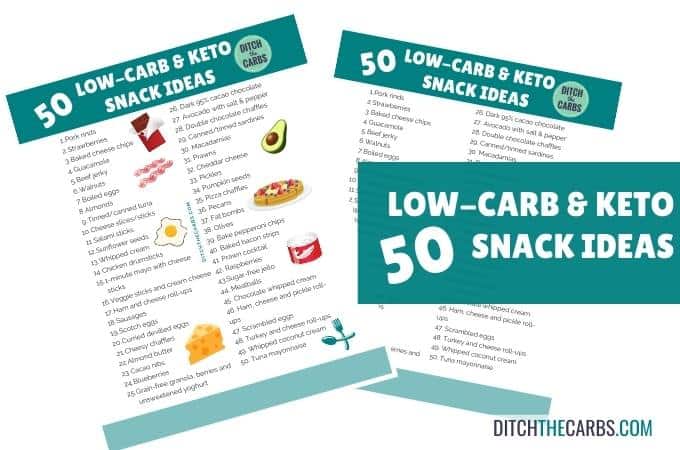
Get your FREE printable list - 50 Easy Low-Carb And Keto Snacks
Popular snacks such as chips, crackers and other processed snack foods are all high in carbohydrates and are usually enjoyed in large quantities within a short period of time.
Just think of all those social gatherings with various snacks platters- it’s something we have all gotten used to!
When planning your snacks, consider healthier, low-carb options such as guacamole with celery sticks. Here are 35 Best Low Carb Snacks to choose from.
HOW LONG DOES IT TAKE TO STOP CRAVING CARBS?
There are various reasons why carb cravings arise. These could include:
- Lack of electrolytes
- A lack of fibre in your diet
- Insufficient water
- Practising “dirty” or “lazy” keto instead of “clean” keto
- Boredom or stress
- General fatigue - your body looks for energy from food sources when you don’t get enough sleep
- A macronutrient split that needs revision based on your current state
There’s no doubt that you will still crave carbs at the beginning of your transition from a high-carb intake to a low-carb and keto diet as your body is still adjusting.
Once you reach the state of ketosis where your body is using fat as energy instead of relying on carbohydrates, your cravings will dissipate dramatically, if not all together.
As everyone is different, it may take your friend a much shorter time to reach ketosis than you. Some reach ketosis in a matter of a few days while others take a week or longer.
Regardless, you shouldn’t compare yourself to anyone else but rather stick with it while making sure to get enough water and electrolytes to fight off any chances of getting keto flu.
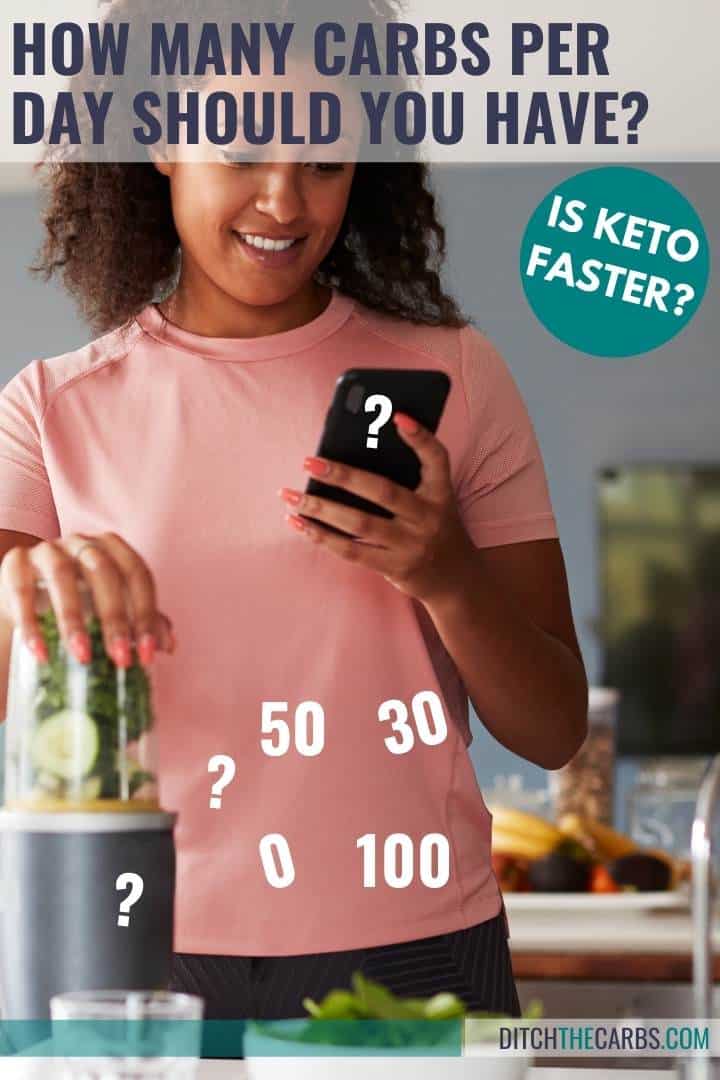
THE BOTTOM LINE
Determining how many carbs you should be eating per day really depends on what kind of weight loss goal you have set for yourself.
What’s so great about a low-carb and keto diet is the fact that it will not only set you up for weight-loss success but will also improve your overall health when you practice “clean eating” with maximum nutritional benefits.
Instead of restricting daily calories which can result in a slower metabolism over time and a general sense of unsustainability and deprivation, the low-carb and keto lifestyle adheres to a daily carb limit by including healthier fibre-rich carb sources. This turns you into a fat-burning machine as your body switches from using carbohydrates to fats while in ketosis.
https://ift.tt/3mltpnX
via Ditch The Carbs https://ift.tt/2w2wCSt
April 4, 2021 at 05:06PM
0 Comments